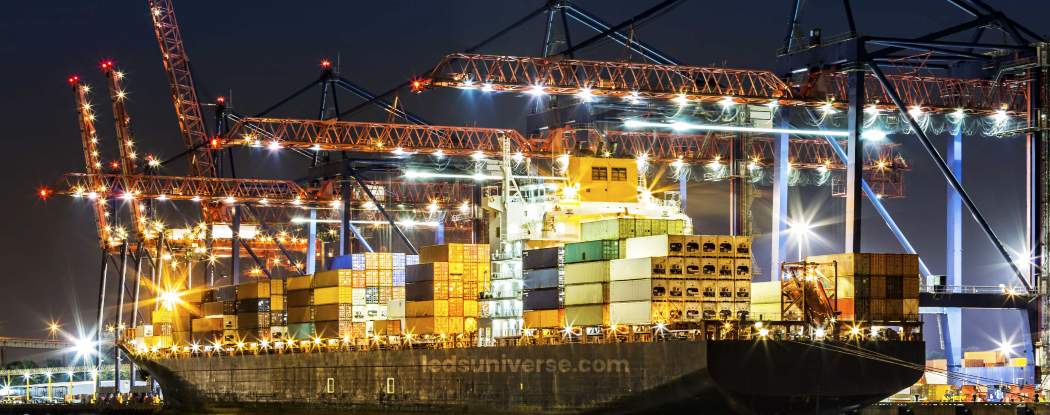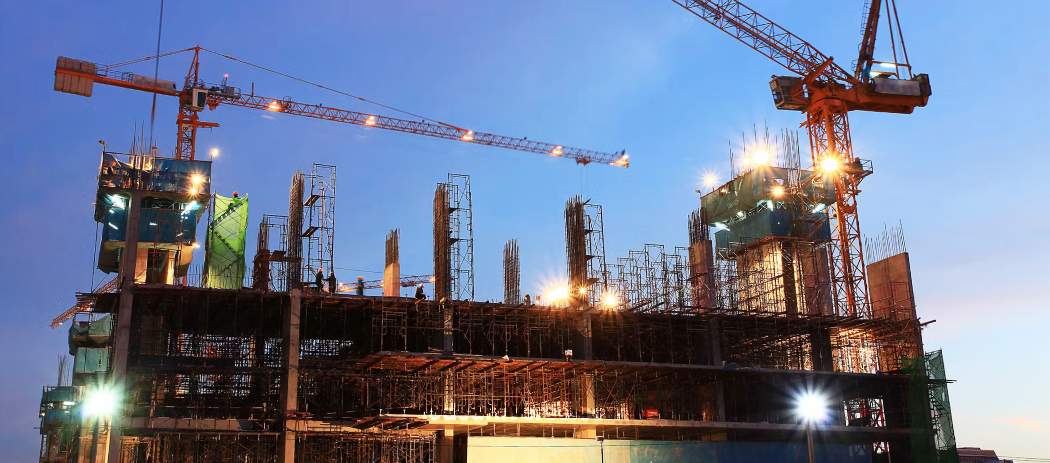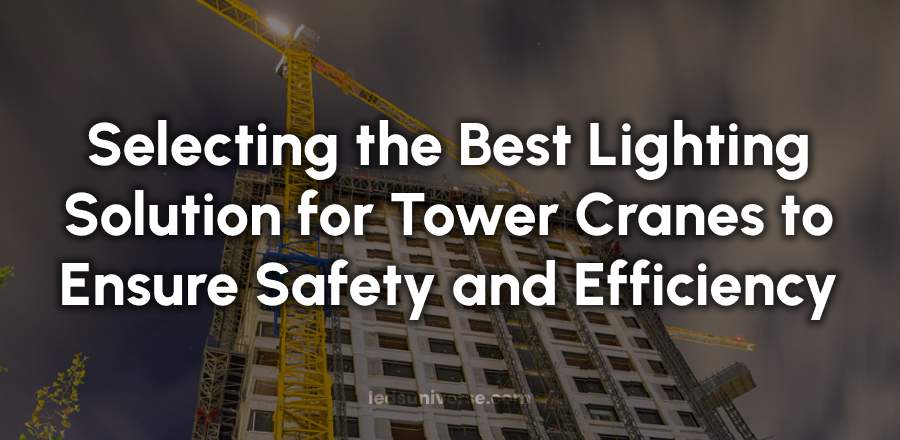Tower cranes, which are commonly used to lift and move heavy loads at great heights, require well-thought-out lighting solutions to allow operators and ground workers to perform their tasks with accuracy and clarity. Whether during the early hours of the morning, late at night, or under adverse weather conditions, proper lighting ensures that the entire work environment remains visible and safe.
Table of Contents
ToggleLighting Considerations for Tower Cranes
When choosing the appropriate lighting for tower cranes, there are several considerations that should be addressed to meet the needs of the construction site. The type of work, the size of the operational area, and the particular challenges that may arise from the environment all play a role in determining the right lighting solution. By analyzing these aspects, it becomes easier to create a well-lit, safe, and efficient workspace.
Work Area Size and Layout

The size and layout of the construction site influence both the type of lighting fixtures to be used and how they are positioned. Larger workspaces generally require more expansive lighting coverage to illuminate wide areas where cranes may be lifting and moving materials over significant distances. In such instances, floodlights or lights with wide beam angles can be appropriate, as they are designed to cast light over large surfaces.
On the other hand, smaller and more confined work areas often call for spotlights or lights with narrower beam angles. These focused lighting solutions help target specific areas and are ideal for tasks that require a high degree of precision, such as load inspection or assembly work. Choosing lights that match the crane’s height and the distance between the fixtures and the ground can optimize brightness levels, ensuring that the entire workspace is sufficiently illuminated.
Impact of Height on Lighting Requirements
Tower cranes operate at substantial heights, often requiring lighting solutions that can efficiently reach both the crane operator and the workers on the ground. The height of the crane affects how much light is needed to maintain visibility for the operator, especially when they are working at the crane’s maximum boom length. To ensure proper lighting, fixtures must be installed with sufficient output to illuminate large vertical areas. This means lights with high wattage and durable materials are typically required to maintain visibility from such heights.
Furthermore, the angle of the lights should be carefully calculated to prevent shadows or dark spots from forming on critical work areas. Poorly angled lighting can result in obscured views, causing delays in task performance and increasing the potential for accidents. By carefully planning how lights are placed, both the operator and the ground crew can have a clear view of the crane’s movements and surroundings.

Types of Tasks Performed by Tower Cranes
Lighting needs can differ greatly depending on the tasks being performed by the crane. Certain tasks demand high levels of visual clarity and may require more intense or specific types of lighting, while others may not need as much brightness.
High-Precision Tasks and Lighting Needs
When tower cranes are used for tasks that require high precision, such as delicate assembly work, detailed inspections, or complex load handling, lighting must be bright enough to provide sharp visibility. High-intensity lighting with cool color temperatures can help workers discern finer details, ensuring that their tasks are performed accurately. Cool light, often in the range of 5000K to 6000K, mimics daylight, providing clarity and reducing eye strain during tasks that require sustained visual concentration.
In these scenarios, targeted lighting, such as narrow-beam spotlights, may be a better option to focus the illumination on specific areas where precision is needed. For instance, crane operators might need focused lighting on a load they are lifting to clearly see hooks, cables, and attachment points. Similarly, workers on the ground need to see how loads are being secured and where materials are being placed.
Tasks with Lower Visual Demand
Other tasks performed by tower cranes may not require as much precision and can be completed with more general lighting. For example, moving materials from one part of a construction site to another or placing large prefabricated sections in place may not require the same level of detail-oriented lighting. In such cases, warmer lighting with a lower intensity can suffice. Lights in the range of 2700K to 4000K can create a comfortable working environment without causing unnecessary glare or distraction for workers.
By matching the lighting levels to the type of task being performed, construction sites can achieve better efficiency and reduce the energy consumption of lighting systems. This makes the site safer while also optimizing the crane’s operational output.
Identifying Specific Lighting Needs and Challenges
Each construction site presents unique challenges, and these must be taken into account when selecting the best lighting solution for tower cranes. The nature of the work environment, power availability, and any specific regulatory requirements are just a few of the factors that should be considered to ensure proper illumination.
Availability of Power Sources
One of the practical considerations when choosing lighting solutions for tower cranes is the availability of power sources. In some cases, construction sites may be located in remote areas where access to a stable electricity supply is limited. In such scenarios, lighting solutions must be adaptable and capable of running on alternative power sources such as batteries or solar panels.
Solar-powered lighting systems are increasingly being used in construction settings as they can be mounted on cranes or nearby structures and provide continuous lighting throughout the night without the need for a direct connection to the grid. Battery-powered lights are another option, offering flexibility and portability that allows them to be moved to different areas of the site as needed. The duration of the tasks performed by the crane, as well as the availability of recharging facilities, can influence which alternative power solutions are most appropriate.
Durability and Weather Resistance
Construction sites are often exposed to harsh environmental conditions, from heavy rain to high winds or extreme temperatures. Any lighting solution installed on a tower crane needs to be durable enough to withstand these conditions without compromising performance. Selecting lights that are rated for outdoor use, with high ingress protection (IP) ratings to safeguard against dust and moisture, can ensure their longevity and functionality.
In addition to environmental factors, the movement of the crane itself creates mechanical vibrations that can damage or loosen poorly installed lighting fixtures. Lights that are designed to resist these vibrations, with secure mounting options and shock-resistant components, can help reduce maintenance requirements and prevent lighting failures that could lead to reduced visibility.
Meeting Industry Standards and Regulations
Construction projects, particularly those in regulated industries or urban areas, are subject to safety and compliance standards regarding lighting. These standards may dictate the minimum levels of illumination required for different areas of the site, particularly for safety-critical tasks. In addition to lighting intensity, regulations may also govern the color temperature of the lights, their placement, and the duration for which they must remain operational.
For example, nighttime operations in heavily trafficked urban areas may require tower cranes to be equipped with lights that minimize glare and do not interfere with nearby road traffic or buildings. In such instances, choosing lights with precise beam control and anti-glare properties can ensure compliance while still meeting the operational needs of the construction site.
Consulting with Lighting Experts
While selecting the best lighting solution for tower cranes involves a combination of technical and practical considerations, construction managers may not always have the expertise required to make informed decisions. Consulting with lighting experts can help ensure that the correct solution is chosen based on the specific needs of the project.
Benefits of Expert Advice
Lighting experts bring specialized knowledge of how different types of lighting fixtures perform in construction environments. They are familiar with the latest technologies in energy-efficient lighting, such as LED systems, which offer lower power consumption and longer operational lifespans compared to traditional lighting options. This expertise can prove invaluable when trying to balance lighting performance with cost considerations, as experts can recommend solutions that deliver long-term savings without sacrificing safety or visibility.
By working with a lighting expert, site managers can receive guidance on how to plan the layout of lighting fixtures, taking into account factors such as beam angles, color temperatures, and placement to achieve optimal illumination. Experts can also offer insight into the durability of various lighting products, helping construction teams avoid frequent replacements or repairs caused by the harsh working conditions of a construction site.
Tailored Lighting Solutions
In many cases, a one-size-fits-all approach to lighting tower cranes is not sufficient due to the varying demands of construction projects. Consulting with an expert allows for the customization of lighting systems that are tailored to the specific requirements of the site. Whether it’s determining the best power solution for a remote location, selecting lights with the appropriate level of durability for a harsh environment, or ensuring compliance with safety regulations, lighting experts can design and recommend systems that are uniquely suited to the job at hand.
Conclusion
The selection of lighting solutions for tower cranes is a multi-faceted process that requires careful consideration of the work area, the tasks being performed, and the specific challenges of the construction environment. Proper lighting not only enhances the safety of crane operators and ground workers but also improves productivity by ensuring that tasks can be performed with greater accuracy and speed.
By considering factors such as work area size, lighting intensity, power sources, and regulatory requirements, construction managers can make informed decisions that support both safety and efficiency. Consulting with lighting experts further ensures that the selected system is appropriate for the specific demands of the project, helping to create a well-lit, safe, and productive construction site.
